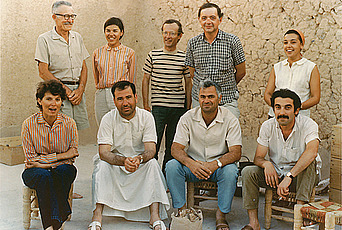Most scholarship on Ottoman art takes the fifteenth and sixteenth centuries as their focus, the glorious periods of the building of the Topkapı Palace in Istanbul, the well-known domed mosques of the architect Sinan, the Iznik pottery, the floral Ottoman silks, and of course, the illustrated histories. It is generally accepted that the second half of the sixteenth century was a time when a recognizable visual idiom was developed for ceramics, textiles, architecture, and eventually illustrated manuscripts.1 Literature and history came to be written in Ottoman Turkish rather than Persian, and local inflections could be detected everywhere, not only in the visual arts but in most aspects of cultural expression, from law to cuisine. This was a period of self-definition and consolidation for the Ottoman Empire, after vast amounts of new territory had been conquered.
Ottoman art and architecture from the second half of the sixteenth century very much condition our expectation of what Ottoman art is, and this is no coincidence, they were created with the express purpose of defining an imperial tradition. The illustrated manuscripts of the period tried to give the sense of an unchanging, ever-present Ottoman imperial order. In a recent essay on ornament, Gülru Necipoǧlu suggests political and religious rivalry between the Ottomans and the Safavids of Iran (1501–1726) during the middle of the sixteenth century was the leading cause of the differing visual idioms adopted by the two empires.2 By the end of the sixteenth century, an identifiable "Ottoman" visual idiom had been created for illustrated manuscripts, constituting a deliberate move away from Persianate styles of painting, illumination, and even calligraphy.3 These manuscripts have received substantial scholarly attention over time, so much so that one might think they were produced throughout Ottoman history, spreading over its 700 years of existence. Rather, their production is limited to the last 50 years of the sixteenth century. Produced in a relatively short time, these majestic works defined once and for all the ideal shape of the Ottoman court and dynasty.
However, when one turns away from illustrated histories and examines the evidence available in albums produced at the Ottoman court around the same time, the landscape is quite different. Overwhelmingly, Ottoman imperial albums produced in the sixteenth century display a Persianate aesthetic, and incorporate artworks from Timurid and Safavid Iran. It is well-known that Safavid works, or works produced in Safavid lands, were appreciated by Ottoman courtiers. The Ottoman-Safavid wars of 1578–90 created a context for the acquisition of Safavid artworks by Ottoman grandees, and we also know that there was a vibrant art market in Shiraz during the second half of the sixteenth century, where Ottoman courtiers procured many luxury volumes.4 But Ottoman production and Ottoman collecting are two different things. As explained above, Ottoman production continued to diverge from Persianate styles during the sixteenth century. The question remains then, why did Ottoman album makers continue to prefer the Persian aesthetic? And did the use of this aesthetic have any meaning?
Let me first try to explain the difference between albums and illustrated manuscripts. In his seminal work on Persian albums, David J. Roxburgh defines albums as “bound collections of calligraphy, painting and drawing” that can be conceptualized in widely different ways, but that share an intention to preserve and display.5 The term used for albums in the Perso-Islamic world is muraqqaʿ, meaning patched, such as a patched garment, and is used for albums to evoke their patchwork or collage-like character. The earliest extant albums date to the Timurid courts of the early fifteenth century, and their popularity as an art form increased in the second half of the sixteenth century.
Albums have been the recipients of more intense scholarly attention since Roxburgh’s groundbreaking publications demonstrated that these were not scrapbooks containing random materials, but rather were meaningful compilations that embodied well-defined art historical narratives and contained visual discourses on aesthetic criteria.
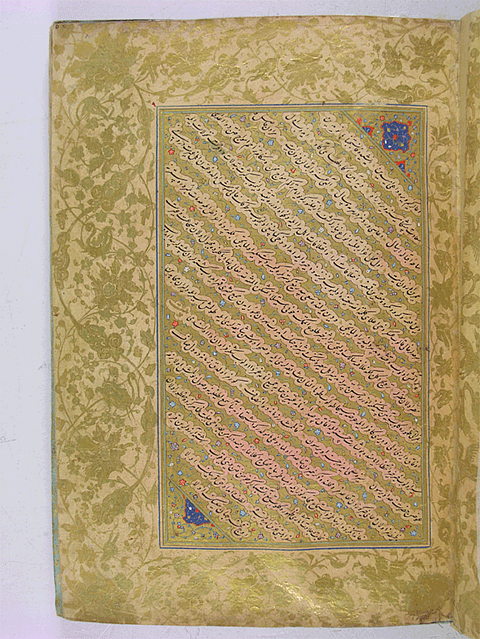
Although much work remains to be done, we learn from recent publications that album making at the Ottoman palace started during the reign of Mehmed II (r. 1444–46, 1451–1481) or his son, Bayezid II (1481–1512), soon after the album genre gained in popularity at the Timurid court, perhaps as a response to Timurid practices.6 Two early sixteenth century albums, Topkapı H 2153 and H 2160 have recently been attributed by Gülru Necipoǧlu to Ottoman production in the early sixteenth century. These albums incorporate a vast variety of materials, from European prints to Persian paintings, drawings and calligraphies, to Chinese artworks. They also include a smaller subset of Ottoman works. Necipoǧlu underlines the exotic nature of the materials collected and juxtaposed in them, suggesting that they demonstrate a meditation on aesthetic differences via symmetrically composed bifolios.7
Sixteenth century albums such as the muraqqa’at-i Shah Mahmud-i Nishapuri of c. 1560, prepared for Sultan Süleyman (r. 1520–1566) and currently in the Istanbul University Rare Book Library Collection, include exclusively Persian material, in this case calligraphy by the Safavid master of the nastaliq script, itself a script generally reserved for the Persian language, and closely associated with Iran. An album prepared for the sultan Murad III (r. 1574–1595) from 1572, while including drawings by Ottoman court artists, privileges calligraphy from 15th and 16th century Persian calligraphers, again almost exclusively in the nastaliq script.8 The nastaliq samples in these albums are surrounded by Ottoman illuminations of bold florals which bring aesthetic unity to the materials they frame and locate them firmly in the Ottoman context, indeed marking the final product, the album itself, as Ottoman.
Aimée Froom attributes the Persian materials in the album of Murad III to the difference between private and public patronage, and an enduring taste for the exotic, where she interprets the Persian materials as foreign. She suggests that illustrated histories, like architecture and textiles, were for public enjoyment and albums for private viewing.9 But like the illustrated histories, albums too were viewed in group settings at court, and were kept in the treasury. They were not necessarily more private than manuscripts, and it would be a mistake to brush aside the meaning of the Persian materials in them as a collector’s folly for the exotic.
The album of Mehmed III (Topkapı Palace Library ms. No H 2165), itself also full of Persian artworks and Ottoman paintings that mimic Persian examples, and even Safavid margins, is a case in point. The contents of the album are all aesthetically superior pieces. As Banu Mahir has published in detail, the material collected here falls into various groups: a small number of 15th century Timurid works (including calligraphy and Chinese inspired bird and flower pictures), large numbers of Safavid drawings, paintings, and calligraphies from the two Safavid capitals Qazwin and Isfahan (thus spanning the last half of the sixteenth century and the beginning of the seventeenth), and Ottoman works that include earlier, Qazwin inspired paintings as well as those datable to the last decade of the sixteenth century.10 The album contains two exquisite cut out calligraphies (on folios 30b and 47b), Ottoman texts relating to political and military events from the reign of Mehmed III, and Ottoman poetry.11
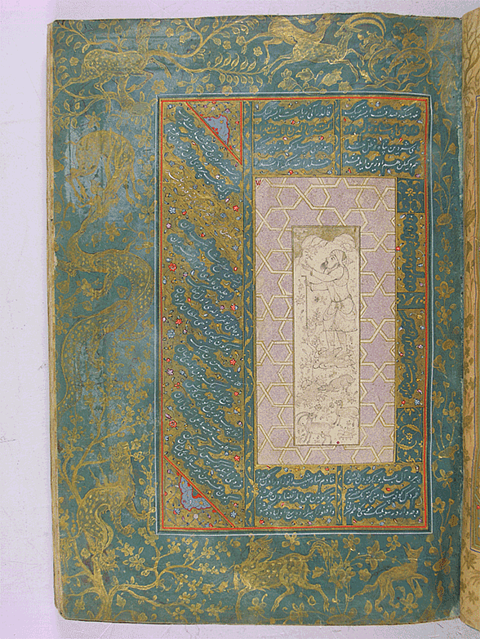
The greatest difference between H 2165 and other Ottoman albums from the period is the inclusion of copious texts from contemporary documents. Rather than being pasted in like the “artistic” materials in the album, these texts are written directly onto the album pages (so the originals are not preserved here, just the contents), as if this were a manuscript (fig. 1, fol. 8a). This suggests to me that the texts are not included for their calligraphic value, but for their contents. None of them are signed, which strengthens my assumption about their valuation as content bearers. The texts begin on folio 8a. Prose sections are written in diagonal lines across the page, as poetry often is in other manuscripts (fig. 1). When the texts are verse, they are written in columns like poetry, and within the columns can be diagonal or horizontal, and are at times written sideways (fig. 2, fol. 16a). Many (like fig. 3, folio 33b) are written in areas surrounding a central image or central calligraphic sample, and their diagonal composition in these instances is reminiscent of Timurid anthologies that contain two separate texts, one in the central text block, and another in the margins.12 In H 2165, however, the historical documents can occupy both the central part of the text block (as in fig. 1) and the surrounding areas (as in figs. 2 and 3), but they are not in the margins, which are predominantly left for illumination. The texts are often written on blue ground in white ink (fig. 2), and are always illuminated. Another idiosyncrasy is the use of the nastaliq script for copying these texts. Ottoman language texts were often copied in naskh at this time, almost certainly if they were prose works. Nastaliq was reserved in Ottoman imperial manuscripts for Persian poetry, and is a more decorative script. In other words, despite the valuation of content over form, these texts are still highly embellished. This is probably because they are incorporated into an object of visual beauty: the album. Their heavy embellishment suggests the value placed on their contents, for sure, but also the primary importance of rich decoration for the album makers.
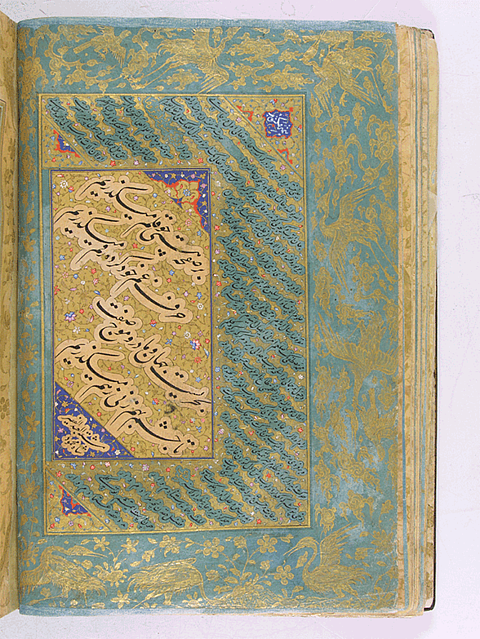
The sheer number of pages with such Ottoman texts on them and their heavy decoration despite being valued for their content raises the question of why they are included here. It is possible to think of these texts as injecting a local, Ottoman flavor into an otherwise predominantly Safavid album. Most of the images and the calligraphies in the album are Safavid or Timurid, and the Ottoman ones are created to mimic Safavid or Timurid examples. There are two exceptions to this Persianate aesthetic—the Ottoman content of the texts themselves (but, as noted above, not their nastaliq execution), and the portraits of Ottoman sultans on folios 24a, 61b, 67a, 68a. One of the identifying characteristics of the Ottoman imperial visual idiom is the frequent use of the ruler’s portrait, something we do not find in Safavid painting until much later, and even then in rather limited numbers and contexts. So the Ottoman texts (historical documents and poetry), together with the Ottoman portraits, help to localize this album in the Ottoman courtly context. The contents of the texts at times relate to Ottoman-Safavid border skirmishes and contested areas such as Baghdad, and so bring up issues of comparison and competition between the two empires. Do these texts then signal the Ottomanness of this artwork which could easily be identified as Safavid?
I find it significant that in an era when an Ottoman visual idiom that could easily be distinguished from the Safavid one was already highly developed and widely used, the artistic contents of an album made for Ottoman imperial consumption were predominantly echoing Safavid taste. Indeed, this close emulation of Safavid albums distinguishes H 2165 from other Ottoman albums of the period. In addition to the large numbers of Persian paintings, drawings, and calligraphies and the nastaliq used throughout, the margins too are Safavid in character, and with their lively figurative contents are a far cry from Ottoman manuscript illuminations. While some margins (fig. 1) appear to be Ottoman in execution (roughly one-third), many others (roughly two-thirds, figs. 2,3) are re-used Safavid papers or are imitating Safavid marginal illumination. They contain animal combat scenes, fantastic landscapes, and other figural scenes. This renders them rather distinct from the bold florals of the Ottoman margins of the albums of Murad III or Süleyman the Magnificent.
The figural images in H 2165 are not only predominantly Safavid in style, but also in subject matter, including materials such as emaciated horses, composite animals, captured Uzbek-looking warriors, amorous couples, and conversing dervishes and dandies, which one does not see much in Ottoman production. Another Safavid characteristic concerns the tinting of some margins (indeed entire folios) in blue. Some openings juxtapose blue and gold tinted margins on either side, quite reminiscent of mid-sixteenth century Safavid work such as the Haft Awrang of Ibrahim Mirza.13 The binding, too, is rather un-Ottoman, with animal combat scenes executed in lacquer rather than the more typical leather.
This Safavid “look” might have something to do with the large numbers of calligraphy pieces and albums that were given as imperial gifts to the Ottomans by the Safavids during the second half of the sixteenth century.14 The treasury collections at the Topkapı now had an impressive collection of Persian albums as a result of decades of gifts and booty from Safavid Iran. An especially rich hoard of gifts was presented by the Safavids in 1576. In addition to the single sheets of calligraphy enumerated by the Venetian bailo in his description of these gifts, the Shah Tahmasp album in Istanbul was probably also gifted at this time.15 Another Safavid gift album is described in glowing terms by the Ottoman chronicler Lokman when recounting the arrival of the Safavid prince Haydar Mirza in Istanbul in 1590.16 Even more relevant for H 2165 might be the arrival of many manuscripts and an album as gifts from the Safavid shah in 1582, for the celebration of the circumcision of the then prince Mehmed.17 Arcak demonstrates that Ottomans received Safavid gifts as symbols of subservience, and that the gifting of artworks was part of a competitive discourse among the two dynasties.18 Certainly the reception of such impressive albums of painting and calligraphy would have inspired competitive feelings among Ottoman courtiers and artists. It is possible to view Ottoman albums as responses to the exquisite Safavid works now in their collections. It is quite likely, though impossible, to prove that the Timurid and Safavid materials included in H 2165 were pulled from those imperial gifts. If that is the case, then this album makes an imperial statement of power and superiority. It includes documents related to Ottoman military glories in the reign of Mehmed III, and if I am right in guessing that the Persianate materials are pulled from Safavid gifts (many given during Mehmed III’s lifetime) that affirmed Ottoman superiority in symbolic terms, then the album underlines that superiority as well.
By the end of the sixteenth century, the album genre was a well-established Safavid medium, with fewer examples from the Ottoman side.19 From the inclusion of Timurid/Chinese materials to the Safavid borders, the makers of this album were careful to include categories of materials one sees in Safavid albums by this date. The works of calligraphers esteemed at the Safavid court, repeating visual motifs such as the captured warrior on fols 45b and 6b (fig. 4, fol. 45b), the juxtaposition of different styles such as Nakşi’s work on folios 61b and 68a, Ottomans imitating Safavid production on folio 23b, Safavid materials associated with different historical periods and styles, and paintings from manuscripts juxtaposed with single drawings all help to create the necessary variety for producing a rich album. Another category one expects in a Safavid album is comparative materials that test the connoisseur’s sensibilities.20 Such an approach is suggested by many folios here but in particular folios 45b (fig. 4) and 6b. These images are intertextual in character, referring to each other, but also to many other examples outside of this particular album. They model courtly behavior and connoisseurship—the signature on folio 45b is a case in point. Perhaps this album was also meant to counter the perception of Mehmed III as only interested in simple stories in Turkish, creating a more refined image for the ruler as someone who appreciated intricate arts and could follow the intertextual dimensions as a good connoisseur should.21
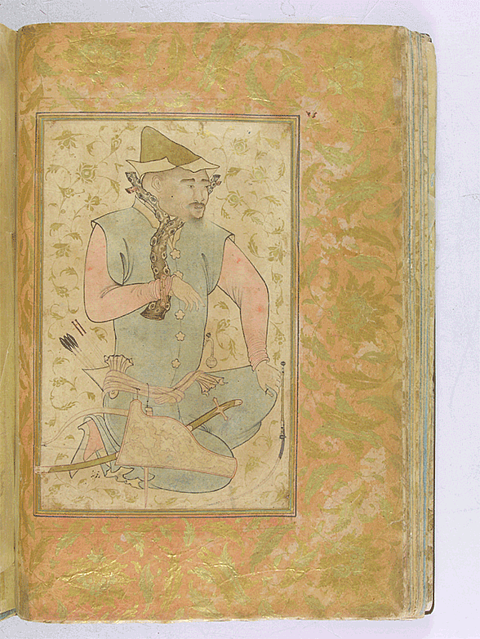
The juxtaposition of Persianate materials with the Ottoman verbal content which preserves documents from the Ottoman-Safavid wars creates an impression of comparison and rivalry. In this case, Ottoman ownership of Safavid materials appears as a discourse of domination.22 The album supports Necipoǧlu’s argument linking Ottoman-Safavid political rivalry to aesthetic developments.23 Prepared soon after the Safavids had given multiple albums and artworks as gifts to the Ottomans, the album of Mehmed III is entangled in a discourse of imperial rivalry.
However, a later example titled the Album of the World Emperor Sultan Ahmed Khan from the reign of Ahmed I (r. 1603–1617) shows us that the landscape had changed significantly during the first 15 years or so of the seventeenth century.24 That album too incorporates Persian-looking materials, both paintings and calligraphies, alongside genuine Persian (Safavid) and Ottoman works. Like the early sixteenth century examples H 2153 and H 2160 cited above, the Album of the World Emperor Sultan Ahmed Khan juxtaposes materials from a variety of different contexts. Its final message is, however, to show the Ottoman traditions of painting and calligraphy to be a hybrid mixture of all the different styles incorporated in the album. The album materials demonstrate that Ottoman patrons and artists were interested in collecting foreign works of art and displaying them alongside Ottoman specimens, in order both to demonstrate their refinement as collectors and to lay claim to vast artistic traditions as a sign of imperial prowess. The role that Persian materials play in the different Ottoman albums, in other words, is varied, reminding us of the importance of historicizing each work and carefully analyzing its contents to understand nuances.
1Gülru Necipoǧlu, “A Ḳānūn for the State, a Canon for the Arts: Conceptualizing the Classical Synthesis of Ottoman Art and Architecture," in Soliman le magnifique et son temps, ed. Gilles Veinstein (Paris: Documentation Française, 1992), 195-216; idem, “L’idée de décor dans les régimes de visualité islamiques” in Purs décors? Arts de l’Islam, regards du XIXe siècle. Collections des Arts Décoratifs, ed. Rémi Labrusse (Paris, 2007), 10-23, and Emine Fetvacı, Picturing History at the Ottoman Court (Bloomington: Indiana University Press, 2013).
2Gülru Necipoǧlu, “Early-Modern Floral: the Agency of Ornament in Ottoman and Safavid Visual Cultures,” in Gülru Necipoǧlu and Alina Payne, eds., Histories of Ornament: From Global to Local (Princeton, NJ: Princeton University Press, 2016), 132-155, esp 136.
3Necipoǧlu, “A Ḳānūn for the State, a Canon for the Arts,” Fetvacı, Picturing History at the Ottoman Court.
4Filiz Çaǧman and Zeren Tanındı, “Remarks on Some Manuscripts from the Topkapı Palace Treasury in the Context of Ottoman-Safavid Relations,” Muqarnas 13 (1996): 132-48; Lale Uluç, Turkman Governors, Shiraz Artisans and Ottoman Collectors: Sixteenth Century Shiraz Manuscripts (Istanbul: Türkiye Iş Bankası, 2006).
5David J. Roxburgh, The Persian Album 1400-1600: From Dispersal to Collection (New Haven and London: Yale University Press, 2005), viii.
6Lale Uluç, “The Perusal of the Topkapı Albums: A Story of Connoisseurship,” in Julia Gonella, Friederike Weis, Christpoh Rauch, The Diez Albums: Contexts and Contents (Leiden, Boston: Brill, 2017), 121-162.
7Gülru Necipoǧlu, “Persianate Images Between Europe and China: The “Frankish Manner” in the Diez and Topkapı Albums, c. 1350-1450,” in in Gonella et al, The Diez Albums, 531-591.
8Aimée Froom, “Adorned like a Rose: The Sultan Murad III Album (Austrian National Library Cod. Mixt. 313) and the Persian Connection,” Artibus Asiae 66/2 (2006): 137-54.
9Froom, “Adorned like a Rose.”
10Banu Mahir, “Sultan III. Mehmed İçin Hazırlanmış Bir Albüm: III. Mehmed Albümü”, 16. Yüzyıl Osmanlı Kültür ve Sanatı 11-12 Nisan 2001 Sempozyum Bildirileri (Sanat Tarihi Derneǧi: İstanbul, 2004): 169-186, esp 172-75.
11Mahir, “Sultan III. Mehmed İçin Hazırlanmış Bir Albüm,” 175-177 describes the contents of some of these documents.
12See for example Thomas W. Lentz and Glenn D. Lowry, Timur and the Princely Vision: Persian Art and Culture in the Fifteenth Century (Los Angeles and Washington D.C.: Los Angeles County Museum of Art and Arthur M. Sackler Gallery, Smithsonian Institution Press, 1989, 118 and 119, catalog numbers 35 and 37, for two early 15th century examples of Timurid anthologies which contain both text and images.
13Marianna Shreve Simpson, with contributions by Massumeh Farhad, Sultan Ibrahim Mirza’s Haft Awrang: A Princely Manuscript from Sixteenth-Century Iran (New Haven: Tale University Press, 1997).
14Sinem Arcak, “Gifts in Motion: Ottoman-Safavid Cultural Exchange, 1501-1618,” Ph.D. Thesis, University of Minnesota, 2012. See also Filiz Çaǧman and Zeren Tanındı, “Remarks on Some Manuscripts from the Topkapı Palace Treasury in the Context of Ottoman-Safavid Relations,” Muqarnas 13 (1996): 132-48
15Arcak, “Gifts in Motion,” 119.
16Arcak, “Gifts in Motion,” 172, quoting from Lokman, Shahnama-i al-i Osman, BL Add. 7931
17Arcak, “Gifts in Motion,” 131, from Mustafa ʿĀlī, Cāmiʿu’l-buhūr der Mecālis-i Sūr, ed. Ali Öztekin (Ankara: Türk Tarih Kurumu, 1996), 25.
18Arcak, “Gifts in Motion.”
19Serpil Baǧcı, Filiz Çaǧman, Günsel Renda and Zeren Tanındı, Osmanlı Resim Sanatı (Istanbul: T.C. Kültür ve Turizm Bakanlıǧı, 2006), 225-239; Roxburgh, Persian Album, 309-325, Banu Mahir, “XVI. Yüzyıl Osmanlı Nakkaşhanesinde Murakka Yapımcılıǧı,” Uluslararası Sanat Tarihi Sempozyumu, Prof. Dr. Gönül Öney’e Armaǧan, 10-13 Ekim 2001, Bildiriler. (Izmir, 2002): 401-17.
20Roxburgh, Persian Album, 188-196.
21For such an image of Mehmed III, see Fetvacı, Picturing History, 46-48.
22Emine Fetvacı, “The Album of Mehmed III: Some Thoughts on its Nature and Contents,” forthcoming in S. Baǧcı, A. Erkmen, and Ş. Tamcan, eds. Prof. Dr. Zeren Tanındı’ya Armaǧan: Islam Dünyasında Kitap Kültürü ve Sanatı
23Necipoǧlu, “Early Modern Floral,” 136.
24Emine Fetvacı, “The Album of Ahmed I,” Ars Orientalis 42 (2012): 127–38; Serpil Bağcı, “Presenting Vaṣṣāl Kalender’s Works: The Prefaces of Three Ottoman Albums,” Muqarnas 30 (2013): 255-313, esp. 263–69.



